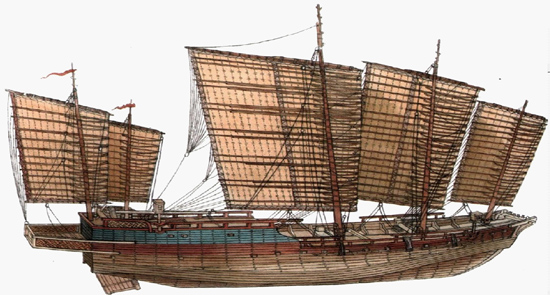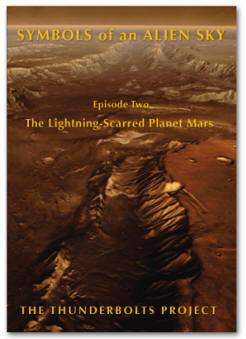|

The Chinese junk. Artist unknown.
Mega-Tsunamis, Chinese Junks and
Port Phillip Bay
Aug
17, 2011
The Australian Bunurong tribe
recorded the catastrophic formation
of Melbourne’s Port Phillip Bay in
their mythology.
“Plenty long ago, you could
walk dry foot from our side of the
bay to Corio. Then, in a night of
destruction, great tornadoes
uprooted all the trees and giant
seas rushed in through the
headlands. The land sunk under
shattering earthquakes and the seas
became void and deep, just as they
are today.” Georgiana McCrae
When did these events occur? In 1450
AD, the catastrophic comet Mahuika
descended upon the coast of New
Zealand. Reputed to be twenty-six
times as bright as the Sun, it
discharged electrically and
shattered Admiral Zhou Man’s Chinese
fleet of some sixty ships. The fleet
supported a thriving Chinese colony
of Han, Tang and Song, mining gold,
jade and antimony in New Zealand.
The comet’s screaming noise blew out
the sailors' eardrums; they received
horrific burns.
Earthquakes and gigantic waves that
could have been more than 200 metres
high tossed the ships upside down
like matchsticks, whilst the intense
heat caused the masts and rigging to
catch fire. Zhou Man’s wrecked hulks
hurtled across the seas to New
Zealand and southeast Australia
fanned by 600 kilometre per hour
winds. Junks were flung ashore at
Bairnsdale, Warrnambool, King
Island, Kangaroo Island and even the
tip of West Australia. Sound
incredible?
These facts are recorded in the
meticulous fifteenth century records
of Chinese ambassador Zheng He.
Historian Gavin Menzies
claims that over nine hundred ships
failed to return to China from
Pacific expeditions in that tragic
year.
Professor Ted Bryant recounts how
matching Maori South Island
mythology speaks of the
Fires of Tamatea.
They describe “the falling of the
skies, raging winds and massive and
mysterious fires and storms from
space.” The catastrophe was centred
on Tananui (Maori for "the big
explosion") where the airburst
flattened trees within a radius of
80 kilometres. Vast forests caught
fire. The Chinese colonists were
burned alive. Flocks of the
flightless Moa bird were incinerated
and became extinct. Manu Whakatan
translates as “the bird felled by a
strange fire.” Local names describe
the fireball: names such as, "Waitepeka,"
"Kaka Point" and "Oweka" (Ka
is Maori for "fire").
A deluge followed the fire. The
Invercargill plains, including the
Chinese mine shafts, were flooded.
Trees were toppled by the
mega-tsunami. Maori place names
inland reflect this: "Tainui," "Tairoa,"
"Paretai" ( Tai being
Maori for "waves"). Zheng He's
records and the Maori mythology
agree.
Aboriginal myths from Port
Phillip Bay, Newcastle, and
Wilcannia on the southeast coast of
Australia also describe falling
debris, cataclysmic floods,
earthquakes and heavenly auroral
fires. Physical evidence of wrecked
junks was discovered by marine
engineer Cedric Bell, who
investigated the hypothesis of a
fifteenth century tsunami. Bell
surveyed the coast of New Zealand’s
South Island. Magnetic instruments
showed 44 large junks buried in the
sand or amongst inland chevrons. One
treasure ship was impaled in a cliff
at Moorak. Two burning junks were
hurled into the cliff face at
Wakanui Beach, their wreckage buried
deep beneath a tsunami formation
enclosing a stone-built Chinese
canal.
Turning to Port Phillip Bay,
there is abundant evidence for a
destructive mega-tsunami. Layers of
burnt cliff top and shells stretch
endlessly around Port Phillip Bay
and the Victorian coastline. Burnt
trees protrude along the shorelines.
Chevrons (20-30 metre high sand
incursions) invade the coastline
along Wilson’s Promontory, Portsea,
Warrnambool and beyond. The sand
chevrons are solid evidence for
tsunamis washing inland for many
kilometres. Carbon dating of the
burnt shell remains appears to
validate the fifteenth century
catastrophe.
Conventional geology insists on a
slow creation of Port Phillip Bay in
a post ice age (Pleistocene) event
occurring some ten thousand years
ago. However, recent research from
the University of Melbourne confirms
this formation occurred within the
last thousand years. This was a
catastrophic event.
Peter Mungo Jupp
 New
DVD New
DVD
The Lightning-Scarred
Planet Mars
A video documentary that could
change everything you thought you
knew about ancient times and
symbols. In this second episode of
Symbols of an Alien Sky, David
Talbott takes the viewer on an
odyssey across the surface of Mars.
Exploring feature after feature of
the planet, he finds that only
electric arcs could produce the
observed patterns. The high
resolution images reveal massive
channels and gouges, great mounds,
and crater chains, none finding an
explanation in traditional geology,
but all matching the scars from
electric discharge experiments in
the laboratory. (Approximately 85
minutes)
Video Selections
Order Link
|





 New
DVD
New
DVD

